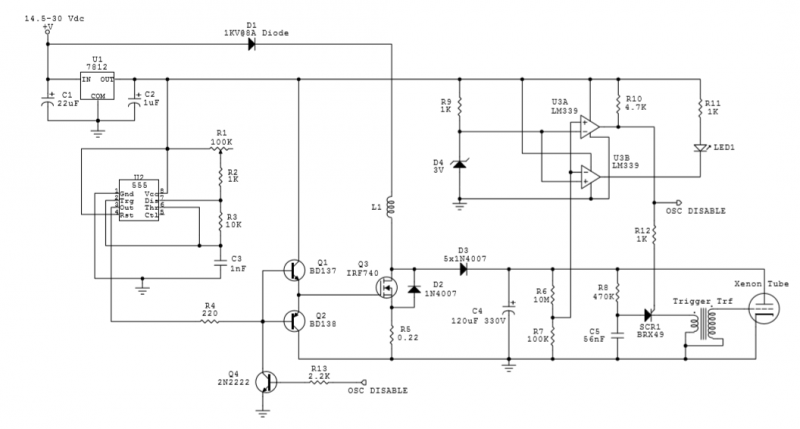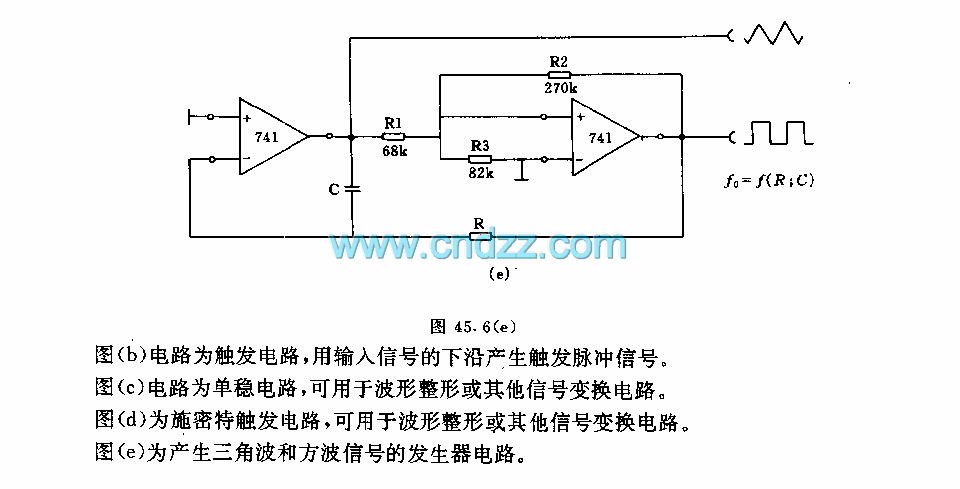
slave flash trigger

The built-in flash of digital cameras is intended for indoor photography. At distances greater than five meters, the light output is often insufficient for satisfactory images. Many cameras lack a hot shoe for an external flash, necessitating the use of a light-triggered slave flash. The built-in flash generates a rapid change in light intensity, which is detected by a photo-transistor in the slave flash. This pulse is transmitted through capacitor C1 to the transistor, which briefly connects the contacts of the slave flash together. The device's sensitivity can be adjusted using potentiometer P1. The circuit can be connected to the shoe contacts of the slave flashgun via a coaxial cable, or it can be integrated into the flash unit itself if space allows and with some DIY skills. This circuit is not compatible with flashguns that have trigger contact voltages exceeding 20 V, nor with cameras that emit multiple preflashes before capturing the main image.
The circuit for the light-triggered slave flash consists of several key components that work in unison to detect the flash from the camera and trigger the slave flash accordingly. The photo-transistor serves as the primary sensor, responding to the rapid light changes produced by the camera's built-in flash. When the camera flash activates, the photo-transistor conducts, allowing current to flow through capacitor C1. This capacitor acts as a coupling device, ensuring that the pulse from the photo-transistor is transmitted effectively to the transistor that controls the slave flash.
The transistor in this setup functions as a switch, momentarily shorting the contacts of the slave flashgun when it receives the pulse from the capacitor. This action triggers the slave flash, resulting in a synchronized flash that complements the camera's built-in flash, thus enhancing the overall illumination for subjects that are further away.
Potentiometer P1 is a crucial component in this circuit, as it allows for the adjustment of sensitivity. By varying the resistance, the user can fine-tune the circuit to respond to different levels of light intensity, ensuring reliable performance under various lighting conditions.
For installation, the circuit can be connected to the shoe contacts of the slave flashgun using a coaxial cable, which provides a secure and stable connection. Alternatively, for a more compact solution, the entire circuit can be housed within the slave flash unit itself, provided there is sufficient space and the necessary skills for DIY integration.
It is important to note that this circuit is limited in its application. It is not suitable for use with high-voltage flashguns that exceed 20 V across their trigger contacts, as this could damage the components. Additionally, cameras that utilize multiple preflashes before the main exposure may not be compatible, as the circuit is designed to respond to a single flash event. Proper consideration of these limitations is essential for successful implementation in photographic setups.The flash that is built into digital cameras is designed for indoor photography. At subject distances of greater than five meters or so, the light is usually not powerful enough to take a satisfactory picture. Unfortunately most such cameras do not include a shoe for an external flashgun, and so a light-triggered slave flash is called for.
The fla sh built into the camera produces a very rapid change in light intensity which is picked up by a photo-transistor in the slave. The pulse is transmitted via C1 to the transistor, which then briefly shorts the contacts on the slave gun together.
The sensitivity of the device can be adjusted using P1. The circuit can be connected to the shoe contacts of the slave flashgun using a coaxial cable, or, with space permitting and a nimble bit of DIY, can be built inside it. The circuit is not suitable for use with flashguns which have a voltage of more than 20 V across the trigger contacts, or with cameras that emit a number of preflashes` before taking the picture proper.
🔗 External reference
The circuit for the light-triggered slave flash consists of several key components that work in unison to detect the flash from the camera and trigger the slave flash accordingly. The photo-transistor serves as the primary sensor, responding to the rapid light changes produced by the camera's built-in flash. When the camera flash activates, the photo-transistor conducts, allowing current to flow through capacitor C1. This capacitor acts as a coupling device, ensuring that the pulse from the photo-transistor is transmitted effectively to the transistor that controls the slave flash.
The transistor in this setup functions as a switch, momentarily shorting the contacts of the slave flashgun when it receives the pulse from the capacitor. This action triggers the slave flash, resulting in a synchronized flash that complements the camera's built-in flash, thus enhancing the overall illumination for subjects that are further away.
Potentiometer P1 is a crucial component in this circuit, as it allows for the adjustment of sensitivity. By varying the resistance, the user can fine-tune the circuit to respond to different levels of light intensity, ensuring reliable performance under various lighting conditions.
For installation, the circuit can be connected to the shoe contacts of the slave flashgun using a coaxial cable, which provides a secure and stable connection. Alternatively, for a more compact solution, the entire circuit can be housed within the slave flash unit itself, provided there is sufficient space and the necessary skills for DIY integration.
It is important to note that this circuit is limited in its application. It is not suitable for use with high-voltage flashguns that exceed 20 V across their trigger contacts, as this could damage the components. Additionally, cameras that utilize multiple preflashes before the main exposure may not be compatible, as the circuit is designed to respond to a single flash event. Proper consideration of these limitations is essential for successful implementation in photographic setups.The flash that is built into digital cameras is designed for indoor photography. At subject distances of greater than five meters or so, the light is usually not powerful enough to take a satisfactory picture. Unfortunately most such cameras do not include a shoe for an external flashgun, and so a light-triggered slave flash is called for.
The fla sh built into the camera produces a very rapid change in light intensity which is picked up by a photo-transistor in the slave. The pulse is transmitted via C1 to the transistor, which then briefly shorts the contacts on the slave gun together.
The sensitivity of the device can be adjusted using P1. The circuit can be connected to the shoe contacts of the slave flashgun using a coaxial cable, or, with space permitting and a nimble bit of DIY, can be built inside it. The circuit is not suitable for use with flashguns which have a voltage of more than 20 V across the trigger contacts, or with cameras that emit a number of preflashes` before taking the picture proper.
🔗 External reference





